 |
Report from SIAM DS 2007
May 28 - June 1, 2007
Snowbird, Utah |
Written by
Luz V. Vela-Arevalo (Georgia Tech, Atlanta) |
|
The 2007 SIAM Conference on Applications of
Dynamical Systems took place again at Snowbird, Utah, on May 28 to
June 1. It all started on Sunday May 27 with the arrival of many of
the 720 participants of this conference. The usual stories about lost
suitcases (wallets in some cases) and chatting between old or new
friends almost immediately turned into science discussions. This is
the kind of conference where people take any opportunity to be engaged
in science. One such opportunity was the welcoming reception at the
patio of the Cliff Lodge, where one could also get a taste of Utah's
Polygamous Porter (beer). During the following days the conference
would provide multiple opportunities to discuss science, problems,
career moves, and also to catch up with friends and meet new people.
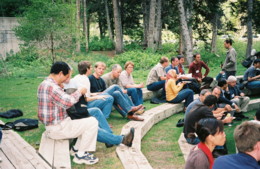 |
|
 |
| Conference participants at the Welcome Reception on
Sunday May 27, 2007; photographs by Susan Whitehouse, SIAM Membership
Manager. |
On Monday May 28 at 8:15 am, you could feel the
activity intensifying at the more than 10 concurrent sessions, with
people locating rooms for the minisymposia and some still trying to
get a quick breakfast. I attended the session on complex networks,
where, surprisingly, the projector worked well with PC's but not with
Mac's. I learnt that the 108th House in the USA Congress (2003-4) has
been the worst in terms of people voting along with their parties
without talking to each other, and this conclusion came from sparse
network rating systems by Mason Porter (Caltech). Data assimilation
was my next topic of choice, and Istvan Szunyogh (University of
Maryland) spoke about feedback between error growth and accuracy of
initial conditions in weather prediction.
At the first invited presentation, the mentioning
of the organizing committee took place: Sue Ann Campbell (co-chair,
University of Waterloo), Arjen Doelman (University of Amsterdam),
Jinqiao Duan (Illinois Institute of Technology), Alain Goriely
(University of Arizona), Aric Hagberg (Los Alamos National
Laboratory), Bernd Krauskopf (co-chair, University of Bristol), Mary
Silber (Northwestern University, and Mary Lou Zeeman (Bowdoin
College). Following the opening remarks, Ed Ott (University of
Maryland) introduced Hans Hermann from ETH Zürich, who gave a
very interesting talk about the motion of dunes. Definition: a dune is
a trap of sand grains made by sand grains. After describing the models
for different types of dunes, he showed simulations of the Barchan
dunes that replicate dunes found on the South Pole of Mars.
For lunch, the obvious choices were the sandwiches
in the hotel lobby, and the burrito buffet at El Chanate. The latter
was my choice since I am Mexican, although burritos are hardly found
in Mexico. Snowbird has more eating options, like the made-to-order
sandwiches at the grocery store, a pizza place, and some other
restaurants.
|
Monday afternoon's invited
presentation was by Francisco Valero-Cuevas (Cornell University), who
provided an excellent talk on the complexity of the brain-hand
system. He described the anatomy of the hand and the analysis of
redundant muscles.
There were two blocks of concurrent sessions on
Monday afternoon. I attended a session about some celestial mechanics
problems, where the restricted three body problem was the subject of
Gareth Roberts' work (College of the Holy Cross) about Saari's
conjecture, and Shane Ross's (Virginia Polytechnic Institute and State
University) about a mapping in the kicked problem. Then I headed for a
session about signal processing applications such as epileptic seizure
analysis, food web reconstruction, and detection of damaged
structures. I also could catch part of the session on
recurrences.
|
|
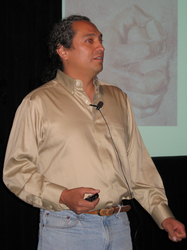 |
| Francisco Valero-Cuevas, Cornell University;
photograph by Hinke Osinga. |
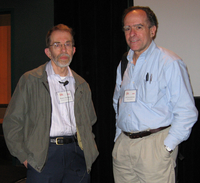 |
|
Monday was a long day,
since in the evening there was the award session and the Jürgen
Moser Lecture. Martin Golubitsky (SIAM Past President) presented the
Ralph E. Kleinman Prize to Salvatore Torquato from Princeton
University, for bringing together applied and pure mathematics,
chemistry and modelling. The J.D. Crawford Prize was presented to
Andrew Stuart from the University of Warwick for his studies of
conditional sampling in stochastic PDEs. The Jürgen Moser Lecture
Prize was awarded to Harry L. Swinney from the University of Texas at
Austin. In his lecture he showed that the ozone hole is persistent due
to KAM tori forming a barrier in the atmospheric circulation at the
South Pole.
|
| Harry Swinney (University of
Texas at Austin) and John Guckenheimer (Cornell
University); photograph by Hinke Osinga. |
Early Tuesday morning I was a couple of minutes
late for Steve Strogatz' talk (Cornell University) on chimera states,
and the room could not fit one more person! It was not a regretful
situation, however, because I attended the talk by Eric Kostelich
(Arizona State University) about estimation of model error in weather
forecasting. In the same session, Evelyn Sander (George Mason
University) spoke about classifications of explosions, and there was a
talk about economic models.
|
The invited talk of
Tuesday morning was by Peter Imkeller from Humboldt University about
large stochastic resonance and Levy noise induced transitions, who
analized how different noise regimes give different results in
Gaussian stochastic differential equations motivated by climate
dynamics. After the lunch break, the invited presentation was by Jane
Wang from Cornell University about the physics of insect flight and
falling paper. She presented experimental and modelling work on
tumbling and fluttering motions.
|
|
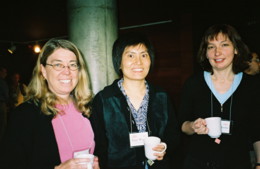 |
| Mary Silber (Northwestern
University), Jane Wang (Cornell University) and Rachel Kuske
(University of British Columbia); photograph by Susan Whitehouse, SIAM
Membership Manager. |
The Association for Women in Mathematics (AWM)
Workshop was part of this year's conference. The participants of the
workshop were young women such as students or recent PhD's starting a
career in mathematics, who were selected and partially funded by the
AWM; I had the chance to be one of them. Mary Lou Zeeman and Mary
Silber organized the workshop. Each of the participants was paired
with a female academic as a mentor, and we all attended a dinner on
Tuesday night at The Summit restaurant. We had the chance to meet with
each other and to know first hand the background and experiences of
successful women with varied careers in different fields of
mathematics. We all introduced ourselves and prepared the mood for the
workshop taking place next day.
 |
|
On Wednesday morning
the first session of the AWM workshop was about dynamical systems and
applications to mathematical biology. This session was attended by the
participants of the workshop and by many others at the conference. The
subjects were dynamic synapses, biochemical reaction networks,
infinite population genetic algorithms, and stability in nonlinear
discrete models.
|
| Maya Mincheva (University of
Wisconsin, Madison), Mihaela Predescu (Bentley College), Christina
Hayes (Gettysburg College), and Anne Catlla (Duke
University); courtesy of AWM. |
The invited presentation of Wednesday morning was
hosted by Philip Holmes, who introduced Ian Couzin from the University
of Oxford. His talk about collective animal behavior and decision
making presented theory, field experiments and simulations in his
integrative approach to explain ant traffic, motion of school of fish,
collective memory and locusts behaviour. I remember his movie of bugs
going in circles and biting each other in the back as to correct their
course, and also his T-shirt with the slogan "Hecho en California."
|
The AWM-SIAM Sonia
Kovalevsky Prize and Lecture was awarded to Lai-Sang Young (Courant
Institute) for her work on shear induced chaos, which was the topic of
the afternoon invited presentation.
The activities of the AWM Workshop continued with a
discussion panel on "Shaping your career in mathematics." The panel
included Barbara Lee Keyfitz from The Fields Institute and the
University of Houston, Deborah Lockhard from NSF, Gerda de Vries from
the University of Alberta, and Emily F. Stone from the University of
Montana. The panellists opened the discussion with their own
experiences in building a career in mathematics, and provided their
insight and advice on what female mathematicians face in their
career: research is the key in this career, the quality of research is
what buys a position; a postdoc is a convenient step towards an
academic position, rather than going directly from PhD to a faculty
position; searching for opportunities wherever you might find
|
|
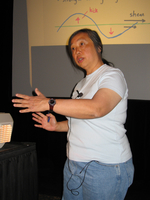 |
| Lai-Sang Young
(Courant Institute); photograph by Hinke
Osinga. |
|
them, such as
travel grants of the AWM; decide the life you want to have, what works
for you, including planning of children, commuting, etc.; take charge of
your own professional development; enhance communication skills for
interviews, papers, grant proposals; maintain a balanced life, not all
can be work; academic positions offer flexibility that a woman can
take advantage of for things like a family; take yourself seriously,
be responsible. The general discussion versed on one recurrent topic:
how to plan an academic career at the same time as a family,
especially about what is a good time to have children, since there is
still a general feeling that your career stops for raising kids. Since
this is not necessarily the case, there was no conclusion about this
topic, there is no better time for having kids, one has to make an
individual decision and do what is best for oneself. Many institutions
are now more flexible about it and it is a case-by-case
scenario. Another point that was raised is that there is not just one
model of an academic career in mathematics, besides a faculty position
in a university, there are other options such as the national labs,
college positions, NSF positions, etc.
|
|
The AWM workshop continued
in the afternoon of Wednesday, with a session about PDEs and physical
systems. My talk was first in this block and it was on quantum
coherent states for the hydrogen atom. There were also talks on
rotational Stokes waves, travelling waves in the Ginzburg-Landau
equation and pattern formation in Rayleigh-Bénard
convection.
|
|
 |
| Vera Hur (MIT), Janet Scheel
(California Lutheran University), Luz Vela-Aravelo (Georgia Tech), and
Claire Postlethwaite (Northwestern University); courtesy of
AWM. |
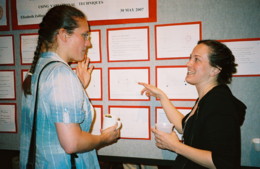 |
|
The poster session on
Wednesday night was as successful as the sweets and desserts offered
to the attendees. I had the chance to chat with participants of the
AWM workshop who presented posters, but also I had a look at many
posters on different topics. I heard about processing of odors with
network models, integrals in celestial mechanics, mixing in
hurricanes, breakdown of WKB, and travelling waves in flame
propagation.
|
| Hinke Osinga (University of
Bristol) with her AWM mentee Elizabeth Zollinger (Boston
University); photograph by Susan Whitehouse, SIAM Membership
Manager. |
Thursday was the last day for me, and since I was
done with my talk, I could be more relaxed. I woke up to attend the
minisymposium about uncertainty propagation in dynamical
systems. Instead of a talk, the last section was reserved for
discussion, and one point mentioned was that uncertainty can work for
you or against you, and the dynamical systems community needs to
embrace this.
The invited presentation for Thursday morning was
by George Haller from MIT, about aerodynamic separation and invariant
manifolds. He promised not to speak about finite-time Lyapunov
exponents --- in my choice of talks during the conference, this was
probably the most recurrent phrase. He showed simulations, theory and
experiments. Before this talk there was an award ceremony for the
winners of the DSWeb Tutorials
Competition, and for the winners of the `red sock' awards for the
best posters.
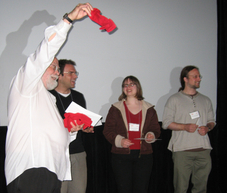 |
|
 |
| Jim Yorke (University of Maryland) with red sock award
winners Daniele Avitabile (University of Surrey), Alethea Barbaro (UC
Santa Barbara) and Marshall Hampton (University of Minnesota,
Duluth). Other winners were Jo Mason (University of Bristol), shown on
the right with her poster, and Jue Wang (University of Wisconsin,
Madison); photographs by Hinke
Osinga. |
During lunch time on Thursday I took time off and
went for a ride in the aerial tram. The tram goes from 8000 ft at its
base, to 11000 ft at the top of Hidden Peak. There was a lot of snow
and we were told it was still possible to ski.
The invited presentation in the afternoon was by
Natalia Komarova from the University of California, Irvine, about
modelling of cancer. Afterwards, I attended a session on different
approaches to the swimming of fish: approximation of vortices by the
average of two fish swimming in parallel; control of robotic fish,
with movies of a robot swimming in a pool; Lagrangian coherent
structures in fish and jellyfish motion; a complete Navier-Stokes
study of three fish and the effect of vortices; and free-body
motion in the presence of a potential jet and oscillation of a nearby
body. For me this was the end of the 2007 SIAM Dynamical Systems
conference, although activities continued on Friday.
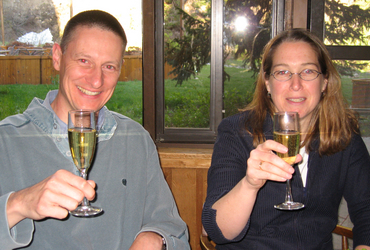 |
| Co-chairs Bernd Krauskopf
(University of Bristol) and Sue Ann Campbell (University of Waterloo)
celebrate a successful Snowbird 2007; photograph by Hinke
Osinga. |